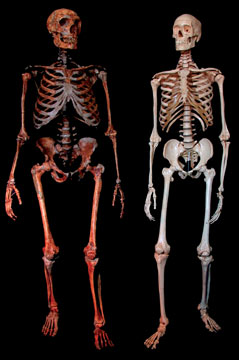|
NEWS NOTES
Paleoclimate
Sudden climate change not Neanderthals' downfall
 Photo: K. Mowbray, Reconstruction: G. Sawyer and B. Maley, Copyright: Ian Tattersall |
| New research suggests abrupt climate change is not to blame for the extinction of Neanderthals (left). Instead, competition from modern humans (right) probably played a large role. |
Although not yet solved, the puzzle of the Neanderthal extinction is getting a little more complete. By correlating dates of the last surviving Neanderthals with the paleoclimate record, researchers found abrupt climate change was unlikely to be responsible for these Neanderthals’ demise. Instead, ever-increasing competition from modern humans may be a more likely culprit. This study also provides scientists with a new tool for matching climatic conditions to archaeological sites in ways that have previously been impossible.
Neanderthals once inhabited much of Europe and settled as far east as modern-day Uzbekistan before disappearing from their last refuges in southern Europe sometime between 30,000 and 24,000 years ago. One popular explanation for this disappearance is the Neanderthals’ supposed inability to cope with climatic changes. Testing this hypothesis has been tricky, however, due to the difficulty in comparing Neanderthal dates with paleoclimate records, says Konrad Hughen, a paleoclimatologist at the Woods Hole Oceanographic Institution in Massachusetts and one of the researchers involved in the study.
Neanderthal bones are often dated using the radiocarbon method, which directly dates organic material back to nearly 50,000 years ago by measuring the amount of radioactive carbon-14 decay. The problem with this method, Hughen says, is that radiocarbon dates don’t actually match true calendar years due to variation in atmospheric carbon-14 levels over time. This means, for example, a radiocarbon date of 14,000 years is actually more like 16,300 years in true calendar years (see Geotimes, February 2004). And the difference between radiocarbon dates and calendar years is not constant, but changes significantly with time, Hughen says.
Researchers have partially rectified this problem by creating calibration curves that convert radiocarbon years into calendar years using tree rings and other methods, but these curves only work for dates younger than 21,500 years. Herein lies the problem: Greenland ice cores, the well-known paleoclimate records of the Northern Hemisphere, are dated in calendar years, making it nearly impossible to correlate radiocarbon-dated Neanderthal sites — which are all older than 21,500 years ago — with these ice cores to determine climate during the Neanderthals’ lifetime. Therefore, correlation studies have been iffy. The new study, however, “circumvents the radiocarbon-calendar year problem,” says paleoecologist Chronis Tzedakis of the University of Leeds in the United Kingdom, who along with Hughen and colleagues published the findings Sept. 13 in Nature.
Using a deep-sea core recovered from the Cariaco Basin off Venezuela, the team created a sort of paleoclimate Rosetta Stone. In previous work, Hughen learned that the climatic events recorded in the Cariaco sea core correlate with Greenland ice cores, suggesting the climatic events affecting the Northern Hemisphere extended down to equatorial regions, too. Unlike Greenland cores, however, the Cariaco core has been radiocarbon-dated. This allowed Tzedakis, Hughen and colleagues to take Neanderthal radiocarbon dates, match them to the Cariaco core and discern what the climate was like in Europe at the time. “It’s a really simple, elegant method,” Tzedakis says. And it is a method that wasn’t possible until a few years ago with the recovery of the Cariaco core — the first sediment core with “both lots of radiocarbon dates and high-resolution paleoclimate records,” Hughen says.
To examine the question of Neanderthal extinction, the team compared the Cariaco sea core to three Neanderthal dates — 24,000, 28,000 and 32,000 years ago — from Gorham’s Cave, Gibraltar, where some of the last Neanderthals are thought to have lived. The two older dates did not correspond with any major climatic events such as abrupt, extreme cooling, while the youngest, most contentious date preceded a gradual onset of much colder conditions. Taken together, these results suggest “we can rule out abrupt climate changes” as a cause of the Neanderthal extinction, Tzedakis says. “But that does not mean we can rule out the role of climate altogether,” he adds.
It is possible, he says, that climatic instability, which the Neanderthals had endured for more than 30,000 years, coupled with increased competition from newly arrived modern humans may have led to the Neanderthals’ extinction.
The team’s results “provide a useful challenge to climate-driven models of human extinction,” says Paul Pettitt, an archaeologist at the University of Sheffield in the United Kingdom. These results don’t necessarily rule out the role of major climatic events in the decline of Neanderthal populations from northern Europe who disappeared earlier in time, he cautions. However, this is something that can now be tested thanks to the new study, he says. Even more exciting, perhaps, than the implications for Neanderthal extinction, though, is the team’s new correlation tool, which can be used to correlate climate changes and other events over the past 50,000 years, Pettitt says.
Indeed, “this [new] method opens the door to evaluating climatic impact on events in the last 50,000 years, both in human evolution and that of other species, as it can be applied to any radiocarbon date,” says co-author Katerina Harvati, a paleoanthropologist at the Max Planck Institute for Evolutionary Anthropology in Germany.
Links:
"The Ice-Free Corridor Revisited," Geotimes, February 2004

 Subscribe
Subscribe


